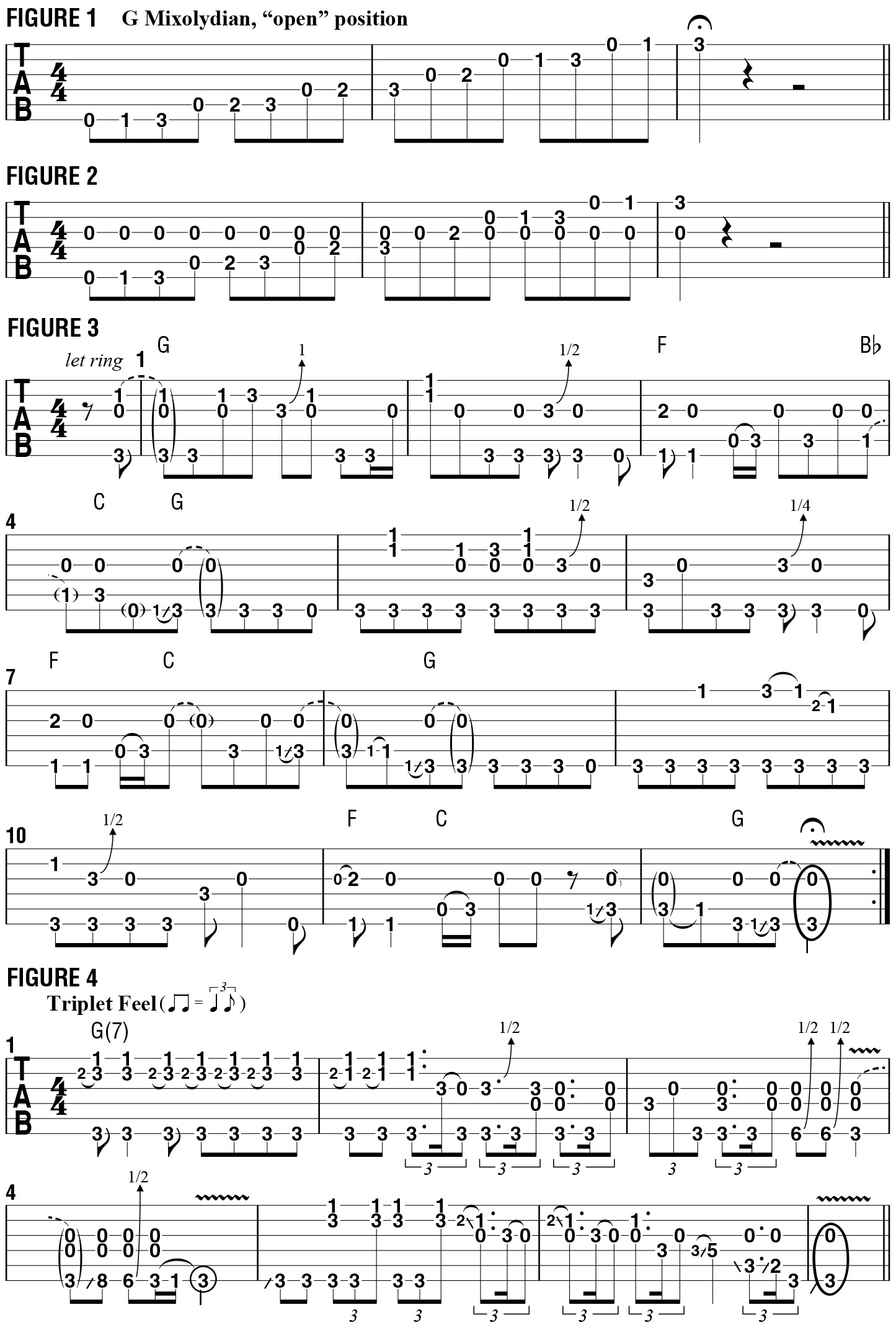More Ways to Use Open Drones for Rhythm and Lead
Last month, I introduced the concept of using a ringing, re-articulated open string as a constant, self-accompanying tone, or drone, with a melody notes played on other strings. The drone, most often the tonic, or root note of the key, establishes a harmonic relationship to and among the other notes. In other words, the inherent tonality/modality of the musical passage is clearly established.
On the guitar, the open strings work very well as drones, and the low E and A strings are often used for this purpose. Another approach is to use the G string and, as it is situated in the “middle of the string pack,” it creates its own distinct challenges while also supplying its own signature musical quality.
In the previous column, melodies were played in conjunction with the open G string. This month, I’d like to add to the technique by additionally utilizing a low G, fretted on the sixth string’s third fret. If I hook my fret-hand thumb over the top of the neck to fret this note, this leaves all four of my fretting fingers free to play notes on the higher strings, providing the greatest amount of melodic options and freedom.

One of modern music’s greatest guitarists, legendary Texas picker David Grissom, has made an art form out of utilizing drones notes within his rhythm parts and solos, and the examples in this column and are inspired by his approach to this technique.
As we had done previously, our harmonic environment for these examples will be the G Mixolydian mode, which suggests a G dominant seven chord (G7). FIGURE 1 illustrates the G Mixolydian mode played in first, or “open,” position. If we play the notes in tandem with the open G string, as demonstrated in FIGURE 2, we hear the harmony that is created when each scale degree is paired with the G root note.
Now let’s apply the drone technique to a swampy, bluesy rhythm part, as presented in FIGURE 3. The thumb frets the low G note while the index finger barres the top two strings at the first fret. Using fingerpicking, a syncopated rhythm is created by picking the low G either simultaneously or alternately against the other, higher notes. Notice that the open G string is included as the chords move from G to F to B to C. It can be a little tricky to perform some of the pull-offs and bends on the higher strings while keeping that low G fretted, so work through each bar of the phrase slowly and carefully.
Using both G notes together in this way effectively mimics the sound of open G tuning, and as such serves to bring the sound of this guitar part into the swampy blues realm. Many of the great Delta blues players, like Robert Johnson, John Lee Hooker and Mississippi Fred McDowell, relied on open tunings such as open G to perform their classic phrases. FIGURE 4 offers an example of this technique in Hooker’s style, with a triplet feel at a relatively slow tempo.
Now that you have a handle on how to navigate through the G7 sound with drones, try devising some lowdown, swampy blues licks of your own.
Get The Pick Newsletter
All the latest guitar news, interviews, lessons, reviews, deals and more, direct to your inbox!
Guitar World Associate Editor Andy Aledort is recognized worldwide for his vast contributions to guitar instruction, via his many best-selling instructional DVDs, transcription books and online lessons. Andy is a regular contributor to Guitar World and Truefire, and has toured with Dickey Betts of the Allman Brothers, as well as participating in several Jimi Hendrix Tribute Tours.
“There are so many sounds to be discovered when you get away from using a pick”: Jared James Nichols shows you how to add “snap, crackle and pop” to your playing with banjo rolls and string snaps
Don't let chord inversions bamboozle you. It's simply the case of shuffling the notes around








![Joe Bonamassa [left] wears a deep blue suit and polka-dotted shirt and plays his green refin Strat; the late Irish blues legend Rory Gallagher [right] screams and inflicts some punishment on his heavily worn number one Stratocaster.](https://cdn.mos.cms.futurecdn.net/cw28h7UBcTVfTLs7p7eiLe.jpg)


